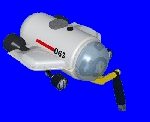
| SUBMARINES SUBMERSIBLES ROVS & SUB-SEA EQUIPMENT. |
TWENTY-FOUR PASSENGER TOURIST SUBMARINE (T-SUB).
NEW BUILD SUBMARINE. JUST COMPLETED.
IMMEDIATELY AVAILABLE FOR SALE .
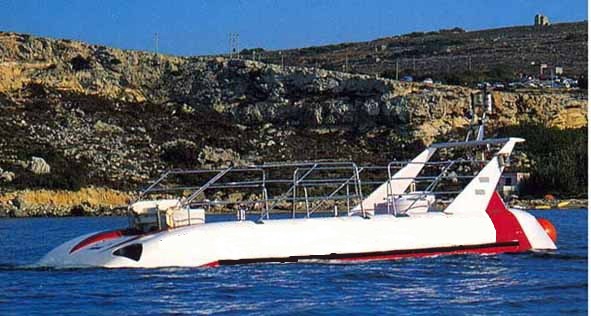
A medium size 24-passenger tourist submarine (T-SUB).
Designed for the underwater leisure market.
Immediately Available with a wide choice of interior and exterior designs and colour schemes.
PILOT AND MAINTENANCE TRAINING WILL BE ARRANGED FOR YOUR CREW, AT YOUR OWN TOURIST RESORT.
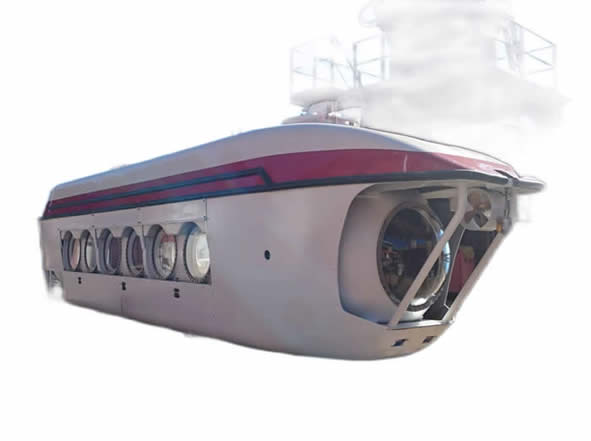
Tourist Submarine for Sale - "The Piranha"
The Piranha is a deep diving, medium size 26 passenger tourist submarine. The reliability, ease of maintenance and ease of transportability are key-noteworthy features. The submarine is designed according to the DnV (Det norske Veritas) and ABS (American Bureau of Shipping) rules for submersible vehicles. This vessel was designed specifically for conventional one hour dive turnaround submarine tourism. It can however be re-configured for different modes of operation. E.g. fewer passengers / longer dive duration; Offshore Casino; Novelty Restaurant; Underwater Hotel; Ultra Secure Meeting Venue; Wedding Venue; Party Venue. The possibilities are endless, with this Fully Customisable Submarine.
Interior Possibilities. Currently, its interior is built for regular underwater tourism operations but it can be quickly changed into anything you wish. The inner space is like the one in private jets. Here, we are presenting a few ideas for the interior design of the Piranha submarine.
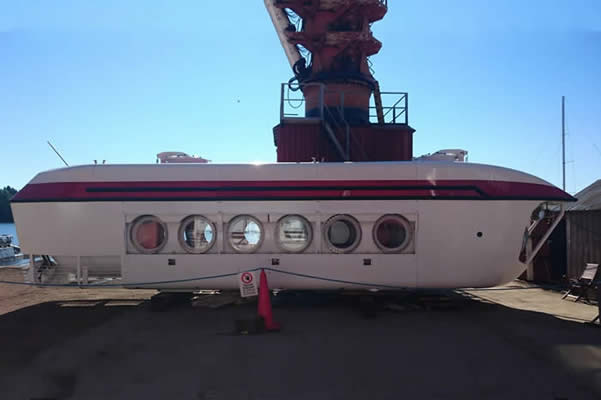
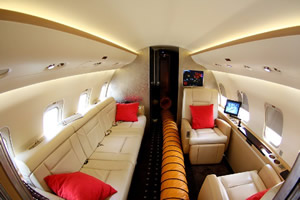
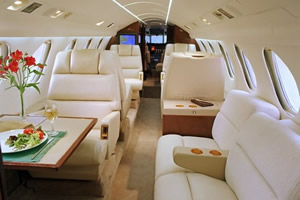
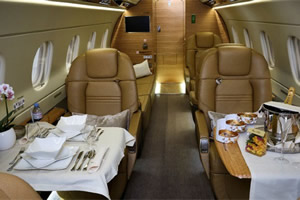

SET UP & TRAINING
A well trained crew is the key to a successful operation. It is recommended that the crew will be selected jointly by the builder and the operator. A submarine pilot should preferably have or obtain a surface license for minimum of similar size surface vessel, prior to or during training as a submarine pilot. The pilot should also be technically oriented and a previous experience in underwater operations will be of advantage.
The copilot should have an engineer’s license for minimum of same size surface vessel. A working knowledge of electronics and electrical engineering is of great assistance. All crew should have as a minimum basic First Aid training.
The training of the crew will take place in two periods. The first one is the technical orientation during the completion of the build, which is included in the purchase price of the system. Where the nominated crew will receive hands on instruction is all aspects of the submarine by participating in the final assembly of the submarine. Specific classroom lectures will be scheduled on a regular basis to cover the theoretical aspects of submarine systems.
We can also offer as a stand-alone selection of (optional extra) training modules. These cover various aspects of tourist submarine operations. As a complete suite, these modules represent a complete operational training package.
Operating the Piranha Tourist Submarine. The submarine should be based at a location, which offers good logistics and high exposure for marketing purposes. The submarine will dive at interesting offshore sites, exploring to maximum depths of 300 feet, but typically to around 100 feet (30m).
Dive time will be about one hour per trip for passengers, with a maximum of ten dives per day. Educational and Scientific dives may also be conducted at certain times and have a dive duration of up to eight to ten hours, subject to local conditions.
OPERATIONS PLAN (OFFSHORE)
Each morning the submarine will be prepared for diving and moved to the selected dive site. Passengers will check in to a reception center, receive a safety briefing, and a pre-dive orientation presentation, before being taken offshore. Once all passengers have boarded, the submarine will descend beneath the water, and explore the local shipwrecks, marine life, and coral reefs.
Powerful underwater lights, sonar, cameras, and various instruments are added to this unique experience. At the end of the dive excursion of around 45 minutes which gives an ideal dive turnaround time of one hour, the submarine will surface. Passengers will return to the reception center, where refreshments and souvenirs will be available.
Each evening the submarine will be serviced, & consumables such as power, O2 & Soda Lime for the CO2 scrubbers will be replenished, in preparation for the next day. Depending upon local conditions, the submarine can complete 8 – 10 dives per day, giving a maximum passenger capacity of 192 to 240 paying passengers per day.
LOGISTICS (ONSHORE)
The onshore facilities would consist of the following units. However, it can be assumed that some existing facilities may already be in place, at certain dive locations.
MAINTENANCE WORKSHOP / STORE
- This unit will be located on a suitable site close to the submarine maintenance berth. It will be equipped as a workshop, and storage area, for all spare parts and consumables.
- The unit will require an electrical power supply 380/415 vac, 50hz, three-phase. (Ideally, this would be derived from a dedicated generator set, afford autonomy & ensure a good clean supply for the battery chargers), freshwater, and good security.
- Auxiliary equipment will include battery chargers, an HP air compressor, and an oxygen supply.
RESERVATIONS / PRESENTATION OFFICE
The office will act as a booking, information, customer check-in center, and sales area. A separate section may also be equipped to offer video and slideshow presentations. Subject to space being available, this center could feature a small museum/submarine display area, souvenir shop, and restaurant.
PERSONNEL
The personnel requirement for up to 6 hours/day operations of the submarine operation will be as follows:-
- Pilot/technician (1)
- Co-Pilot/technician (1)
- Surface Operations Controller
- Reservations/office (3)
For 8 to 10 hours/day operation of the submarine operation will be as follows:-
- Pilot/technician (2)
- Co-Pilot/technician (2)
- Surface Operations Controller
- Reservations/office (3)
This requirement is based on submarine diving 300 days per annum. The personnel level shown may be adjusted to suit operational requirements, shift systems, holiday & illness coverage & any additional diving days organized. Should an offshore vessel be used to support the submarine operation, crew levels and logistics would need to be reconsidered.
TRANSPORTATION
The submarine is compact and easily transported by land and sea (in a forty-foot shipping container). Land transportation is normally carried out by low-loader. Sea transportation is normally achieved by towing, or onboard a suitable vessel.
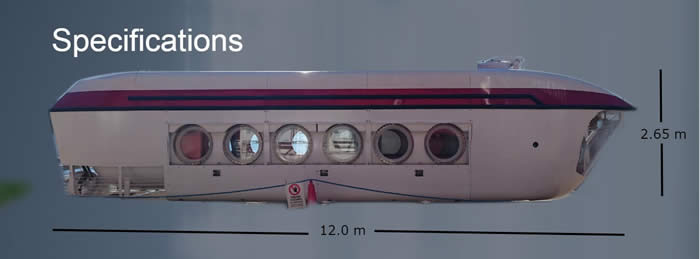
LIFE SUPPORT AND ENVIRONMENTAL CONTROL SYSTEMS
The life support system consists of oxygen, carbon dioxide removal, and air conditioning systems. The oxygen system maintains the internal oxygen level at 21% throughout the dive. There are two onboard oxygen systems (main and reserve), which will support 26 persons for a minimum of 72 hours in emergency situations.
The carbon dioxide is removed with six independent scrubber units. The scrubbers are filled with carbon dioxide removal absorbent (soda lime) that will last for several dives depending on the number of passengers.
The levels of oxygen, carbon dioxide, and flammable gases are monitored continuously with electronic gas analyzers. Any high or low-level concentration is indicated with an audible and visible alarm.
The temperature and humidity are controlled with an air conditioning system based on compressor circulated Freon heat exchangers. The unit is located in the engine room. The cooled air is circulated in the compartments with blowers and ducting.
The hydrogen purge system is located in the pilot compartment. The blowers create suction from the battery compartment and blow air through catalyzing units back to the compartment removing thus any hydrogen from battery spaces.
COMMUNICATIONS
The submarine remains in constant contact with the surface operations controller when dived, by use of the underwater telephone (UWT). When on the surface communication is by use of a marine VHF radio.
ALARM AND MONITORING SYSTEMS
The alarm panel incorporates battery monitoring and centralized alarm systems. Both 248V and 24V battery systems are monitored continuously. In the case of the low battery voltage, an audible and visible alarm is given.
The insulation resistance (IR) system is monitoring power supply routes and measuring any currents that might be leaking to the submarine hull. In the case of fault, an audible and visible alarm is given.
The bilge water level is monitored with a sensor situated at the end of each bilge suction line. In the case of water ingress, a visible alarm is given at the control panel.
EMERGENCY SYSTEMS
For emergency use, a carbon dioxide removal absorbent reserve is stored onboard. This absorbent will be used in the scrubbers and it is sufficient for 72 hrs of scrubbing with a maximum number of passengers on board. During an emergency, the scrubbers will take their energy from the emergency batteries if necessary.
All passengers are provided with individual emergency breathing systems. The system capacity is sufficient to enable the submarine to surface from its maximum operating depth and in a safe manner unload the submarine.
The jettisonable drop weight is provided to be released in the case of an emergency. The drop weight is located underneath the submarine. The weight release is activated by an independent hydraulic circuit. The drop weight can be released or locked with a selector valve and hydraulic hand pump.
The firefighting system is divided into passive and active firefighting systems. Passive firefighting is carried out during the design. Electrical cables and interior materials are selected according to the rules and regulations of classification societies. The fire retardant materials will not maintain a fire. The active system is divided into hand extinguishers, a fixed inert gas system, and an alarm system. All firefighting systems are based on inert gas, positioned in the bow of the submarine, battery compartments, and aft equipment room. These systems can be activated by the pilot. The fire detection sensors are located in the passenger compartment, in the battery purge line, and in the engine room. The sensors will activate the alarm system giving an indication of the location of the fire.
The 24 Volt batteries are divided into emergency and main batteries. In case of a power failure, the emergency batteries will be connected automatically. The 24 V power distributions are divided into essential and nonessential users. When the emergency power is connected on the preselected essential users are coupled on and the rest of the users are turned off. The power distribution is also equipped with a manual override switch. If the pilot wants to use non-essential users during the power failure, he can provide these users with energy by means of using the manual override. The emergency power will disconnect automatically when normal power becomes available.
Special instruments are provided to locate the submarine under surface. The primary device is the surface buoy. The Xenon flasher unit is used to give a visual aid to locate the submarine on the surface or submerged. The surface visibility is up to 10 miles. The battery-powered unit is located on the mast frame and switched on from the pilot control panel.
Standard approved life jackets are fitted to fast release holders above the passenger seats, together with emergency breathing units (BIBS).
Structure and Internal Outfitting of the Piranha Tourist Submarine
The entire submarine is covered with a Glass Reinforced Plastic (GRP) fairing. The passenger viewports are manufactured from see-through acrylic. The fairing is assembled on a steel frame bolted to the hull attachments. The plastic fairing acts as an outer hull protecting the viewports, thrusters, piping, etc., and giving hydrodynamic form.
The upper deck is surrounded by a railing. The large mast frame offers attachments for cameras, lights, and other devices.
The passenger compartment is lined with aircraft-style facia panels. Above the viewports, the panel forms a console gathering emergency breathing system, internal communication system speakers, life jackets, and emergency rations.
PRESSURE HULL
The pressure hull is a cylindrical structure with hemispherical ends and two entrance towers. The pressure hull is divided into three compartments:
- Pilot compartment
- Passenger compartment
- Engine room
The pilot compartment is fitted with one 1000 mm hemispherical viewport for pilot use. The passenger compartment is fitted with 12 viewports, 600 mm each. Entranceways are located in the opposite ends of the passenger compartment. The aft entrance is the main, primary means of access/egress & the forward entrance is the emergency access/egress.
The hull is constructed from DnV classified steel grade NVE or equivalent. All hull welds are 100% NDT tested. The customer will receive material inspection reports and certificates.
PROPULSION SYSTEM
The submarine has a fully hydraulic propulsion system. The main forward/aft control is done with two main thruster units situated at the aft end of the vessel. The lateral thruster unit is placed at a bow above the pilot’s viewport. The vertical control is achieved with one thruster fitted in the bow. The hydraulic system is fully pressure compensated thus following the changes of the external pressure. The tank is mounted outside the pressure hull. The hydraulic power pack and valve block are located in the engine room. The power unit is mounted on vibration dampers and connected with flexible hoses to the system. This will ensure that the noise level is acceptable in the passenger compartment.
ELECTRICAL SYSTEM
The electrical system of the submarine is battery powered from 248V and 24V battery packs. The primary consumers like propulsion, lightning, etc. are powered by 248VDC power. The auxiliary devices like communications, life support, etc. derive their power from 24V batteries. The 248V supply is distributed from a remote-controlled distribution panel in the engine room to the consumers that mostly also are situated in the engine room. The 24V distribution panel is fitted in the pilot compartment. All circuits are selectively fused to protect the all-around function of the submarine.
All batteries are located under the passenger compartment floor. The lead-acid air circulation cell batteries are mounted in acid-proof boxes that are supported to the compartment walls with spacers. This enables free air circulation inside the compartment.
BALLAST AND BILGE SYSTEMS
The soft ballast (air ballast) system is used to give the submarine sufficient freeboard and stability on the surface. The soft ballast system includes external tanks, tank valves, and internal control valves. The tank valves are air-operated normally closed piston valves. At the beginning of the dive, the valves are activated and the air escapes from the tanks causing the submarine to descend. After the valves are closed the tanks can be blown again with pressure air.
The buoyancy of the submarine is controlled with the hard ballast (water ballast) system. The hard ballast system includes internal water tanks, pumps, and valve manifold. The capacity of the system is designed to compensate for the changes in the number of passengers on each dive. If correctly operated then, the immersed submarine will be neutral or just slightly buoyant.
The fixed ballast consists of steel and lead blocks bolted to the submarine’s keel. The exact amount of fixed ballast is determined after the buoyancy tests. Each of the bilges has a separate suction line to the bilge pump located in the pilot compartment.
GAS SYSTEMS
The pressurized air system is divided into main and reserve air systems. The air is stored in two 200bar/250l cylinders. The high-pressure air is brought into the pressure hull via two independent penetrators with internal and external hull stop valves. The air is divided to the consumers in the gas panel located on the left side of the pilot.
The oxygen is also divided into main and emergency systems. The oxygen is stored in six 200bar/50l cylinders. The oxygen is brought into the pressure hull via two independent penetrators with internal and external hull stop valves. The oxygen distribution and flow adjustments are controlled from the gas panel.
NAVIGATION SYSTEMS
Two video cameras are mounted on the top of the mast frame giving the pilot a surface view on a video monitor in the pilot compartment. In front of the pilot, there is mounted the steering control panel incorporating a control joystick, thumbwheels, and thruster function indicators. The other units in the steering console are an echo sounder, (optional extra) magnetic compass, and electronic compass display. Additional units used in navigation are trim and heel indicator and mechanical depth gauge.
The external lights are halogen or LED type giving a high light effect with low power consumption. The lights are mounted on each side below the passenger viewports. The pilot has two forward facing lights.
A surface marker buoy can be used if required to mark the location of the submarine when dived.
Piranha Tourist Submarine - Technical Specs
|
|
Length Overall |
12.0 m |
Width Overall |
2.4 m |
Height to deck |
2.65 m |
Draft on surface |
2.0 m |
Displacement |
35 tons |
Max. operating depth |
100 m |
Drop weight |
800 kg |
Payload capacity |
1750 kg |
Passenger capacity |
24 |
Typical crew |
2 |
Propulsion & Power Supply |
|
Main thrusters |
2 x 10 kW |
Auxiliary thrusters |
2 x 10 kW |
|
|
High voltage |
248 V / 750 Ah |
Low voltage |
24 V / 280 Ah |
Emergency battery |
24 V / 220 Ah |
Battery endurance 24V |
12 + 72 hours |
Battery endurance 248V |
10 hours (normal operation) |
Gas Systems |
|
Soft ballast |
2.5 m3 |
Hard ballast |
1.75 m3 |
Pressure Air |
500 liter at/ 200 bar |
Oxygen |
12 + 72 hours |
FINANCIAL PROJECTIONS
The projections given below are obviously generic by nature. Every resort location in the world will attract different tourist volumes, and have different local costing, for both the submarine operation and support personnel. However, in order to provide general guidance to the possible income and expenditure associated with a twenty-four paying passenger submarine, the following financial projections are given.
The projections are based on the submarine diving 300 days per annum, with an average of ten dives per day. Assuming the submarine will carry a maximum of twenty-four passengers per dive; the daily passenger number could total a maximum of two hundred and forty passengers per day.
The ticket price has been set at US$60 per person, and does not allow for local commissions, and discounts. Some locations can support a higher price than US60 per person & night dives can be charged at typically around 5 – 10% more than a day dive.
EXPENDITURE |
|||
Safety Boat |
$48,000 |
||
Submarine Maintenance |
$48,000 |
||
Submarine Consumables |
$36,000 |
||
Equipment Maintenance |
$110,000 |
||
Reservations Office |
$24,000 |
||
Office Administration |
$12,000 |
||
Wages |
$270,000 |
||
Insurance |
$60,000 |
||
Marketing |
$60,000 |
||
Other Expenses |
$15,000 |
||
Total Expenditure |
$683,000 |
||
|
|||
INCOME |
|||
Project Efficiency |
85% |
75% |
65% |
Dive Sales (US$60) |
$3,672,000 |
$3,240,000 |
$2,808,000 |
Souvenir Sales (5%) |
$183,600 |
$162,000 |
$140,400 |
Total Income |
$3,855,600 |
$3,402,000 |
$2,948,400 |
Pre-Tax Profit |
$ 3,172,600 |
$2,719,000 |
$2,265,400 |
Pilot Control Station.
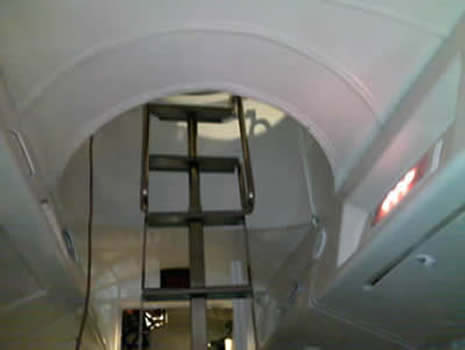
Passenger entry/exit.
Passenger Compartment fitted for tourist operations.
This is a purpose built 26-man tourist submarine (T-sub), designed for passenger comfort and safety.
The submarine provides a panoramic view of the underwater world for all passengers, through large diameter viewports. The submarine operates to a maximum depth of 300 feet (100m) with twenty-four (24) passengers and two crew members. External lighting, VHF, through-water communications, underwater video, and obstacle avoidance sonar system (option), are fitted as standard.
The main features of this tourist submarine include:-
Fifteen view ports * Electro-hydraulic power system * Four hydraulic thrusters * 248vdc dual battery systems * 24vdc dual battery systems * Water hard ballast system * Soft ballast system * Drop weight system * Dual pressure air systems * Dual oxygen systems * Carbon dioxide level monitors * Oxygen level monitors * Carbon dioxide scrubbers * VHF Radio * Ultrasonic underwater communications * Alarm and insulation resistance monitoring systems * Echo sounder * Forward looking sonar system (optional extra)* Mechanical and electronic depth meters * Electronic compass * Trim and heel indicators * Navigation lights * External halogen lights * Emergency breathing masks * Fire fighting systems * Xenon flasher *
The submarine is supported with a service and transport container, complete with battery chargers, high-pressure air compressor, and workshop facility. Plus complete documentation.
MAIN DIMENSIONS.
Length overall |
12.0 m |
Width overall |
2.4 m |
Height to deck |
2.65 m |
Draft on surface |
2.0 m |
Displacement |
35 tons |
Max. operating depth |
100 m |
Drop weight |
800 kg |
Payload capacity |
1750 kg |
Passenger capacity |
24 |
Typical crew |
2 |
PROPULSION AND POWER SUPPLY.
Main thrusters |
2 x 10 kW |
Auxiliary thrusters |
2 x 10 kW |
High voltage |
248 V / 750 Ah |
Low voltage |
24 V / 280 Ah |
Emergency battery |
24 V / 220 Ah |
Battery endurance 24V |
12 + 72 hours |
Battery endurance 248V |
10 hours (normal operation) |
GAS SYSTEMS.
Soft ballast |
2.5 m3 |
Hard ballast |
1.75 m3 |
Pressure Air |
500 liter at/ 200 bar |
Oxygen |
12 + 72 hours |
General Description.
This is a deep diving, mid sized 24-passenger submarine. The key words in the design have been reliability, ease of maintenance, and ease of transportability. The submarine has been designed according to the Det Norske Veritas (DnV) and American Bureau of Shipping (ABS) rules for submersible vehicles. The classification for the vessel is DnV.
The submarine is capable of diving to a depth of 100 m (327 feet). Maneuvering control is executed with a single joystick. The submarine operating systems are located mainly inside the pressure vessel, thus reducing the need for dry-docking during routine maintenance periods.
The submarine iis sold together with a 20-foot support container/workshop and spare parts package. For transportation, a 40-foot flat rack frame is mounted around the vessel enabling easy handling with standard lifting equipment.
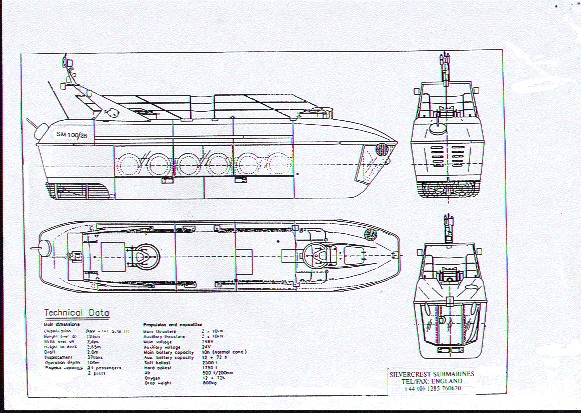
To discuss the purchase or long term charter of this 24-passenger submarine (T-sub) please contact us.
Email: sales@SilvercrestSubmarines.com
Tel: (+44) 1285 760620.
